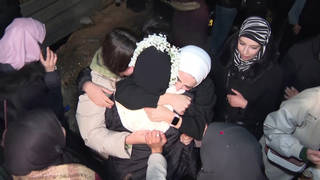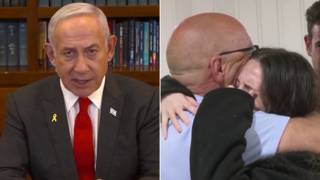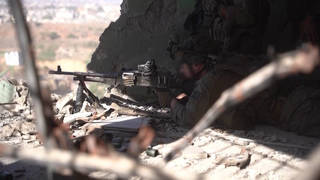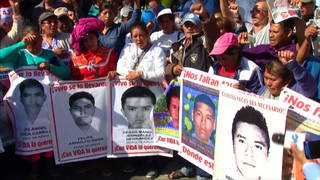
Related
Guests
- Tanalís Padillaassociate professor of Latin American history at Dartmouth College. She is currently a visiting lecturer at University College London. Padilla is the author of Rural Resistance in the Land of Zapata. She is currently writing a book on the history of rural normal schools in Mexico, which is called The Unintended Lessons of Revolution.
- Valeria Hamelhuman rights activist and student organizer. She is a law student at ITAM University in Mexico City.
Protests continue in the southern Mexican state of Guerrero over the disappearance of 43 teachers’ college students missing for more than two weeks following a police ambush. More than 20 police have been detained and accused of collaborating with a drug gang, Guerreros Unidos, that has ties to the city’s mayor, who has fled. Fears over the students’ fate have escalated following the discovery of 10 mass graves. But on Tuesday, Mexican Attorney General Jesús Murillo said DNA tests showed none of the 28 bodies tested so far belong to the missing students. “This particular attack reflects … decades of criminalization of these schools, and a situation where in the current Mexican government it is really hard to tell where the state begins, and where drug cartels end,” says Tanalís Padilla, associate professor of Latin American history at Dartmouth College, who is writing a book on the history of rural normal schools in Mexico. Padilla says the schools offer education to low-income students unserved by the public school system, and have a legacy of political radicalism that has prompted political crackdowns in the past. We are also joined by Valeria Hamel, an activist and law student at Mexico City, where students have launched a 48-hour strike, calling for the students to be returned alive. “These students were politically involved in their communities, so that makes us think this is political,” Hamel says.
Transcript
JUAN GONZÁLEZ: In the southern Mexican state of Guerrero, protests are continuing over the disappearance of 43 students who have been missing for more than two weeks. The students are from a rural teachers’ college called Ayotzinapa. They had gone to the small city of Iguala to gather funds, when police ambushed their buses. Six people were killed in an initial series of attacks. More than 20 police have been detained and accused of collaborating with a drug gang, Guerreros Unidos, with ties to the city’s mayor, who has fled.
AMY GOODMAN: Fears over the students’ fate have escalated following the discovery of 10 mass graves. But on Tuesday, the Mexican attorney general, Jesús Murillo, said DNA tests showed none of the 28 bodies tested so far belong to the missing students.
ATTORNEY GENERAL JESÚS MURILLO: [translated] What I can say is that the first mass grave we found, the very first one from where we already have results, I can say the remains don’t match the DNA of the families of the missing students. The discovery of these mass graves confirms the level of danger of this group that operates in the region called Guerreros Unidos.
JUAN GONZÁLEZ: On Tuesday, authorities said the leader of the drug gang, Guerreros Unidos, which is suspected in the students’ disappearance, killed himself after a battle with federal police.
The students’ disappearance has sparked mass protests across Mexico and around the world. Last week, parents of the victims traveled from Guerrero to Mexico City, where they joined tens of thousands calling for officials to work harder to find the students. Macedonia Torres, the mother of a missing student, said authorities would do more if it was their child missing.
MACEDONIA TORRES: [translated] They will move heaven and earth to find them. This is what we are going to do. We’re going to do whatever it takes to find them, and we will not rest until we do.
JUAN GONZÁLEZ: Protesters have continued to call for the students to be returned alive. In Mexico City, students have launched a 48-hour strike. On Monday in the capital of Guerrero state, demonstrators set a government building on fire. In a separate incident also in that state on Sunday, police opened fire on a van filled with students traveling back from the resort city of Acapulco, hitting and injuring a German exchange student. Authorities said 15 to 20 police have been detained.
AMY GOODMAN: Well, for more, we’re joined now by two guests. We’re going to go first to Mexico City, where we’re joined by Democracy Now! video stream by Valeria Hamel. She is a human rights activist, student organizer, law student at ITAM University in Mexico City.
Welcome to Democracy Now!, Valeria. Can you talk about what’s happened in Mexico?
VALERIA HAMEL: Hi, good morning. Yes, well, as you have heard now, there was—there are 43 students missing after a shooting by local policemen in Iguala, in the city of Iguala in the state of Guerrero. And these students, they were politically involved in their communities, and so that makes us think this is political. You were speaking about the drug dealers being involved in this, and that’s where we would like to intervene in the discussion, because we think this is much more complicated than that. You have to understand, the state of Guerrero, how there’s guerrilla going on, for example, on one side, and there’s also paramilitaries, people like civilians trained, financed and organized by the military, who are also involved in what ends up being the government in this type of places. And so, it’s really complicated what happened there. We assume this is political, and we want these students to appear again.
JUAN GONZÁLEZ: And, Valeria Hamel, could you talk about these rural schools and the conflicts that they often have with local authorities, the history of conflicts with some of them?
VALERIA HAMEL: Yes, sure. This school, in particular, they’re teachers’ colleges, rural teachers’ colleges, where students come from like peasant families and villages around the area, really like rather poor people who go here to be teachers, because it gives them a stable job opportunity. And these are kids who are good at school, and they want to teach their communities. Most of them get also taught to be bilingual teachers, indigenous—both indigenous and Spanish teachers, which is also really interesting how this works.
And these schools, they are really politically organized. They have been so for many, many years. One of the main leaders of the '70s guerrilla thing, war between the government and the rural areas, came from this school. And since then, they've been really organized. There is a big federation of these schools, who are—who claim that they’re socialists. And they are also really—rather, they do extreme measures in their way of doing politics, because they have been pushed to that, because they come from really difficult communities. The government is constantly trying to criminalize them, is constantly trying to take away the funds of these schools. In 2011, two students from this same school were murdered by policemen. So, these students, their reaction is to fight back somehow and to also teach in their schools political knowledge. Not only do they become teachers, but they become also like social fighters.
AMY GOODMAN: In addition to Valeria Hamel, who’s speaking to us from Mexico, we’re joined by Tanalís Padilla, associate professor of Latin American history at Dartmouth College, who’s currently a visiting lecturer at University College London, the author of Rural Resistance in the Land of Zapata. She’s currently writing a book on the history of these rural normal schools in Mexico, which is called The Unintended Lessons of Revolution. Can you put this in a larger context for us, Professor Padilla?
TANALÍS PADILLA: Yes, thank you, Amy. Yeah, the political history, the social history of these schools is really significant for 20th century Mexico. They stem from the social reforms implemented in the 1930s that resulted from the revolution that took place between 1910 and 1920, and were one of the few avenues where peasants could have an education. And so, they were, in one sense, validating the agrarian experience, because at these schools students were also taught or encouraged to cultivate the land and have all sorts of cooperative projects, while at the same time receiving an education. And so, for decades, these schools have sought to preserve the spirit of these social reforms. And after the 1930s, after President Lázaro Cárdenas left office, they have been, as Valeria already noted, either abandoned or outwardly attacked. So, to the extent that they are radical hubs or radical hubs of political organizing, I think must be understood, and to the extent to which the state has abandoned its commitment to education, a commitment that under the constitution it’s supposed to have. And these rural normales constitute part of that larger social program of public education and commitment to the countryside.
JUAN GONZÁLEZ: And, Professor Padilla, the question of the proliferation of these drug cartels and gangs in not only the north of Mexico but in other rural areas of Mexico, and the impact that that’s had on these conflicts with students?
TANALÍS PADILLA: Yeah, so I think these last attacks, these latest attacks, which, again, are not a new attack on normales rurales—they have been criminalized for decades—are basically the logical culmination of, on the one hand, the criminalization of these schools, in which their students are constantly seen not as students but as political agitators—sometimes that’s the best case. Sometimes they’re just seen as people who are kids who just want to destroy public property and sabotage the social order, who are not committed to studying. That’s the way they’re portrayed in the media. So, the fact that this creates a narrative under which they can be attacked by impunity, whether it be the government or whether it be criminal organization, so this particular attack, I think, reflects that logical culmination of the decades of criminalization of these schools and a situation in which the current Mexican government, it’s really hard to tell where the state begins and where drug cartels end.
AMY GOODMAN: And the role of police?
TANALÍS PADILLA: The role of police here is very significant. Again, historically, when students mount any sort of social mobilization here, to just demand simple things like food for these schools, an increase in scholarships, the protection of the infrastructure for these schools, they’re instantly seen as criminals, and the police is then charged with attacking them. And in this last—or containing their mobilization, which often involves attacking them. In this particular mobilization, it’s really significant to see that it was the police who first shot at them, the police who first detained these students and took them, and then, it looks like, handed them over to a criminal organization or to a drug cartel.
AMY GOODMAN: Do you believe the students are still alive?
TANALÍS PADILLA: It’s very hard to tell, honestly. The fact that the DNA showed that they were not those in this mass grave, to a certain extent gives us hope. On the other hand, just the sheer amount of days that have now passed and not turning up, to me, points to a bit of a tragic end. Not to mention, just in the whole context of this is what unfortunately is now becoming the norm in Mexico—mass graves, assassinations. For a long time, political analysts have warned that the militarization of the drug war has been targeting social activists, not just the drug cartels. And I think this becomes very explicit here.
AMY GOODMAN: Tanalís Padilla, we have to leave it there, I’m sorry to say, associate professor of Latin American history—
TANALÍS PADILLA: Thank you.
AMY GOODMAN: —at Dartmouth, speaking to us from London. We’ll certainly continue to cover this. And Valeria Hamel, human rights activist, law student in Mexico City.












Media Options